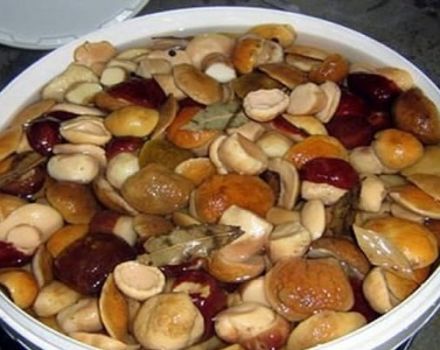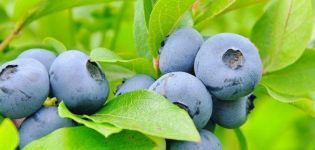Description and characteristics of hybrid goldenrod, planting and care
A perennial plant from the Astrov family, known as the hybrid goldenrod, became the progenitor of many new varieties and species. Another name is solidago. Its lush yellow flowers adorn the site for a long time, but in some countries goldenrod is considered a weed. Before planting any of the varieties of plants on the site, study the requirements of the crop for growing and care.
General description of the plant
In natural nature, the plant is found in America, Asia, Central Russia and Western Europe. Meadows, forest edges, fields - any open area, favorite places for the growth of solidago. In total, about 120 species of goldenrod are known today, but only 20 are used in cultural gardening. They differ in the type of root system, the shape of the crown and inflorescences. The height of the plant depends on the variety and ranges from 30 to 200 cm.
Solidago leaves are characterized by an ovoid elongated shape. Flowers are yellow, appear on goldenrod in early summer and last until autumn. After the end of flowering, a fruit is formed in place of the buds, which looks like a pubescent ribbed achene.
Varieties and types of goldenrod
Among the variety of species and varieties of solidago, there are several that are especially popular with gardeners and landscape designers:
- Common goldenrod. The shoots of the plant are straight or branched, grow up to a maximum of 2 meters. Inflorescences are complex, they are paniculate, racemose or spike-shaped.
- Daursky. This is a bush that grows up to a meter in height. Siberia is his homeland. The shoots are simple, powerful, branching is observed only in the inflorescence. Short hairs cover the upper part of the stem, the lower one is completely naked. Dahurian goldenrod inflorescences are racemose or panicle-shaped and consist of yellow baskets.
Of the varieties of hybrid goldenrod, gardeners value the following:
- Frugold. It grows up to 120 cm.The inflorescences of yellow shade are 25 cm in size.
- Goldstral. The bush in height does not exceed the meter mark. Inflorescences are panicle-shaped and consist of yellow baskets.
- Spetgold. Lemon yellow baskets adorn a meter high bush. Their length is about 20 cm.
- Goldking. One of the tallest varieties reaches 1.5 meters.Its decoration is a rich yellow shade of panicle inflorescences. Their length does not exceed 35 cm.

The subtleties of growing an ornamental culture
The advantages of culture are that it reacts equally positively to both sunny and shady areas. Gardeners practically do not encounter problems when growing goldenrod.
Location
When choosing a location for growing solidago, take into account that the plant is aggressive and instantly fills the entire area, therefore, self-seeding must be controlled. Solidago does not make any demands on the choice of soil. Suitable for cultivation and heavy clay soils, and light fertile. Whether the site will be in the sun or in the shade all day, this will not affect the growth of the plant.
Preparation of planting material
Most often, seedlings are purchased for planting in a specialized gardening store or cuttings are prepared on their own. No special preparation is required before planting; for better rooting, the cut or roots are treated with a growth stimulator.

Landing time and process
It is allowed to plant a hybrid goldenrod in open ground both in mid-spring and early autumn. The step-by-step algorithm consists of the following stages:
- The soil in the selected area is dug up, humus is introduced into it.
- A separate hole is made for each seedling. In this matter, they are guided by the size of the root system.
- Any mineral complex is added to each hole.
- Gently spread the roots of goldenrod along the bottom of the hole and sprinkle with soil, lightly crush.
- After planting, the plant is abundantly moistened.
Care Tips for Goldenrod
The golden rod, as the plant is also called, does not take a lot of time and effort from the gardener and is content with simple care and preventive procedures.
Watering
In those years when there is a sufficient amount of natural precipitation, the hybrid goldenrod does not need additional moisture. But if the weather is hot for a long time and it does not rain, the plant is watered abundantly. Too dry soil causes the development of powdery mildew.
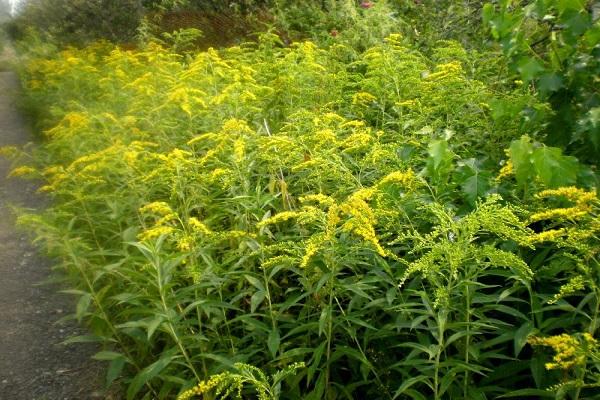
Fertilizer
The introduction of fertilizing compositions is recommended only in cases where the soil on the site is poor and depleted. This will provoke a more abundant flowering of goldenrod. Both mineral and organic formulations are suitable. It is also recommended to occasionally sprinkle the soil with wood ash - this is an effective prevention of powdery mildew. Top dressing is applied twice during the active growing season - in spring and autumn.
Garter and transplant
Low-growing plant varieties do not need a garter, and for tall ones it is recommended to build supports.
It is necessary to move goldenrod bushes to a new place no more than once every 6-7 years. Transplanting too often will only harm the plant.
Pruning
In the spring, the shrub does not need a similar procedure. Pruning is carried out only when preparing goldenrod for winter. In late autumn, before the first frosts hit, all branches are cut off so that only a 10-centimeter stump remains above the ground. But culture does not need shelter for the winter period at all. The hybrid goldenrod is characterized by increased frost resistance and calmly tolerates this time even in the northern regions.
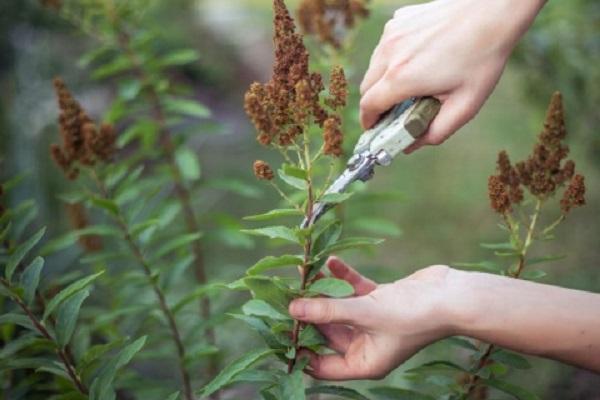
Disease and pest control methods
The main disease that harms goldenrod shrubs is powdery mildew, which is of a fungal origin. In this case, a whitish bloom appears on the ground parts of the plant. The reason is severe drought, too densely located bushes and an excess of nitrogen component in the soil. In this case, treatment with copper sulfate or any fungicidal preparation helps.
Also, sometimes rust appears on the leaves.
The disease is not cured, so infected plants are removed from the site, and healthy ones are sprayed with Bordeaux liquid.
Of the pests, goldenrod is sometimes attacked by a caterpillar, due to which the leaf plates twist. If it is not planned to use the plant for medical purposes, it is sprayed with any insecticide, otherwise only folk remedies for controlling insects are acceptable.
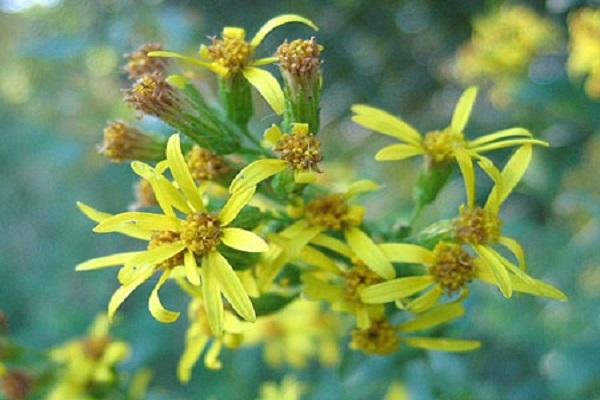
Flower reproduction methods
There are several ways to dilute a flower on a site.
Seeds
Since the seeds of the plant do not retain their germination for a long time, this method is extremely rarely used by gardeners.
Dividing the bush
It is much easier and more effective to use bush division for plant propagation. For this, an adult specimen is selected, which is at least 4 years old. Spill the soil abundantly with water and carefully remove the plant from it. Divide it into several parts (depending on the size of the root system) and plant it in pre-prepared holes.
Rooting cuttings
No less effective is the method with rooting cuttings. It guarantees almost 100% plant survival. As soon as buds appeared on the bush, they begin to harvest the material. For this, only fully formed shoots are selected. They are separated only with a "heel". They are simply buried in the garden, after a short period of time they will take root.
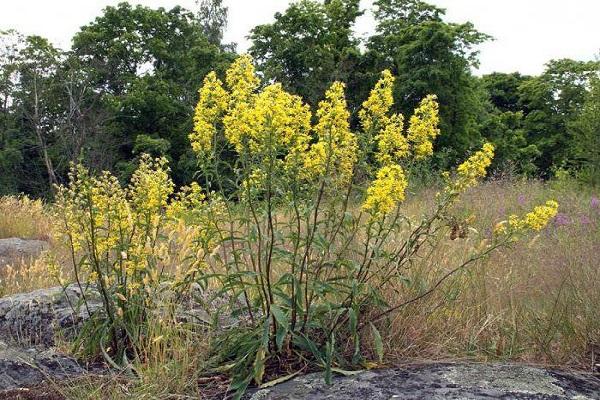
Examples of application in landscape design
A perennial plant looks equally impressive in both single and group plantings. Due to its golden appearance, it is often used by landscape designers. A chubushnik, a juniper, a spirea are selected to join him. Goldenrod looks attractive in combination with ornamental grasses in a mixborder and a rabatka.
The healing properties of the plant
The decorative appearance is not the only advantage of goldenrod. It is also used in the creation of medicines. It has a diuretic effect, therefore it is often prescribed for the treatment of kidney and bladder diseases. Traditional medicine recommends the use of the plant for gout, indigestion, urolithiasis.








